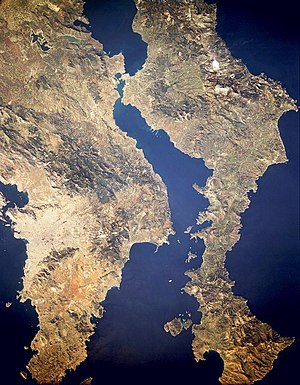
Back Evrip boğazı Azerbaijani Еврип Bulgarian Euripos Breton Eurip Catalan Porthmós Evrípou CEB Úžina Euripos Czech Euripos German Πορθμός του Ευρίπου Greek Eŭbea markolo Esperanto Estrecho de Euripo Spanish

The Euripus Strait (Greek: Εύριπος[1] [ˈevripos]) is a narrow channel of water separating the Greek island of Euboea in the Aegean Sea from Boeotia in mainland Greece. The strait's principal port is Chalcis on Euboea, located at the strait's narrowest point.
The strait is subject to strong tidal currents which reverse direction approximately four times a day. Tidal flows are very weak in the Eastern Mediterranean, but the strait is a remarkable exception. Water flow peaks at about 12 kilometres per hour (7.5 mph; 6.5 kn), either northwards or southwards, and lesser vessels are often incapable of sailing against it. When nearing flow reversal, sailing is even more precarious because of vortex formation.
The Swiss scholar François-Alphonse Forel contributed to an understanding of the enigmatic phenomenon by his study of limnology and the discovery of seiche, where layers of water of differing temperature oscillate in thickness in a confined body of water. But the problem was solved completely only by D. Eginitis, director of the Athens Observatory, who published his conclusions in 1929.[2]
- ^ From Ancient Greek Εὔριπος; R. S. P. Beekes has rejected previous Indo-European derivations and suggested a Pre-Greek one (Etymological Dictionary of Greek, Brill, 2009, p. 482).
- ^ Eginitis, D. (1929). "The problem of the tide of Euripus". Astronomische Nachrichten. 236 (19–20): 321–328. Bibcode:1929AN....236..321E. doi:10.1002/asna.19292361904. See also the commentary about this explanation in Lagrange, E. (1930). "Les marées de l'Euripe". Ciel et Terre (Bulletin of the Société Belge d'Astronomie). 46: 66–69. Bibcode:1930C&T....46...66L.
© MMXXIII Rich X Search. We shall prevail. All rights reserved. Rich X Search